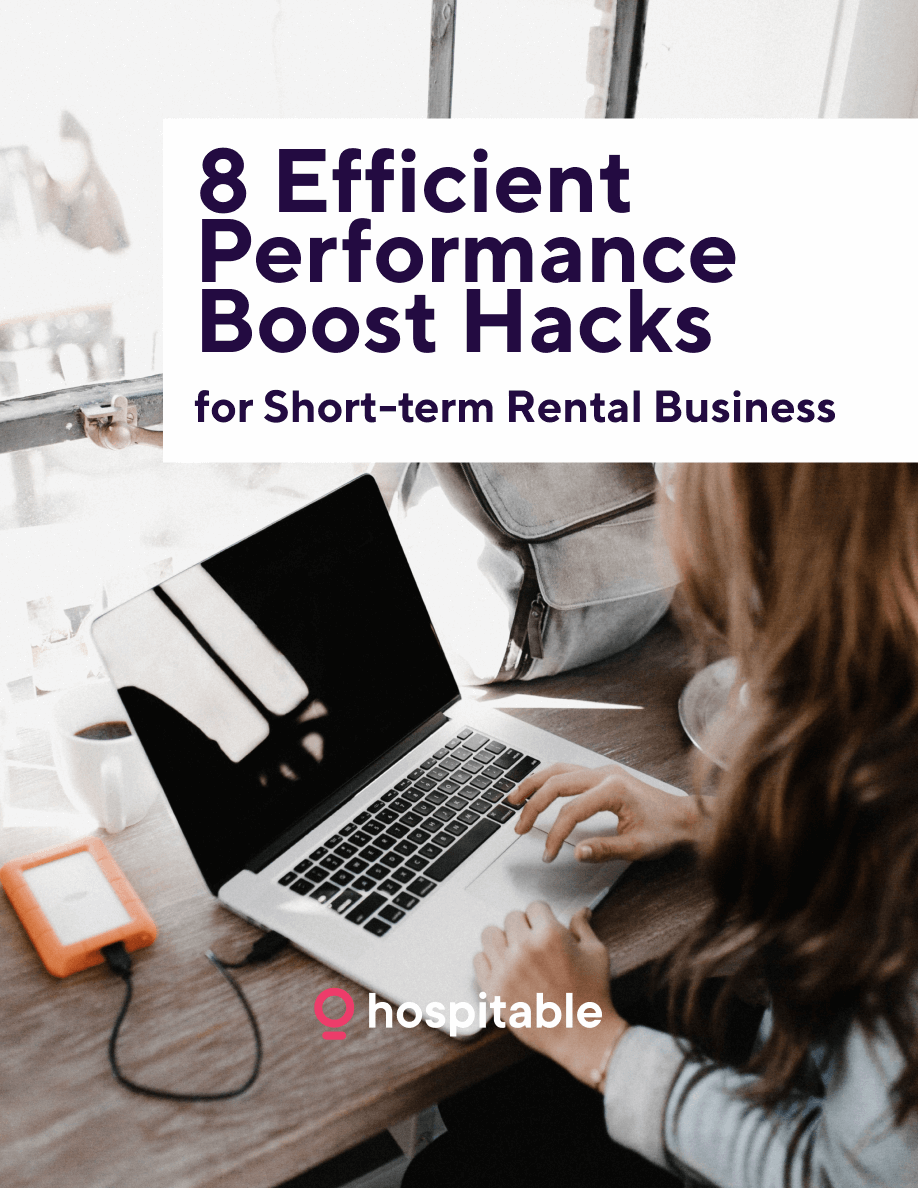By The Hospitable Team
Making more money from your short-term rental Airbnb or Vrbo isn’t just about upping your nightly rate. Raise your rates randomly without proper consideration, and you actually risk seeing your income fall as guests flock to competitors.
But, when done right, raising your rates can actually have the opposite effect—you’ll attract more guests who are happy to pay for an elevated experience.
That’s why we’ve listed our top tips for successfully charging more for your STR.
As part of our research, we’ve asked professional STR hosts for their recommendations, so you can be sure this goes beyond theory—these tips really do work in practice. Here’s how to make more money from your short-term rentals, without simply raising the price overnight and crossing your fingers (because wishing and hoping is not a sustainable strategy!).
Why making more money from your STR isn’t just about raising the price
The seasonality of vacation rentals alongside all the other variables that occur in the vacation industry (which we talk about more, below) means your optimum rates will naturally fluctuate over any given period.
But the majority of hosts adjust their STR rates just once per quarter or less, meaning they’re leaving a ton of money on the table.
So most hosts do need to be more proactive about optimizing rates to maximize revenues, but how to do so without putting guests off?
Well, the secret to making more money from your STR is giving your guests a better experience they’ll pay more for. That way, even with higher rates, you’ll still be offering guests fantastic value.
Here are proven ways to improve your guests’ vacation rental experience:
- Researching your competition
- Upgrading your vacation rental amenities
- Upselling complementary experiences
- Staying on top of local events or trends
- Enlisting automated tools for pricing and communication
And here’s how to do it.
7 ways to earn more from every STR booking
1. Research your competition
When was the last time you checked how your competitors price their rentals? You may have an opportunity to increase your prices if your property is offering a similar experience for too little.
One way to judge this is by comparing similar listings on Vrbo and Airbnb.
Try the following strategy:
- Look at rentals that are very similar to yours. Check location, the number of bedrooms, the quality of the finishes, and amenities. Be as realistic and practical as possible here—a beach-front property with a pool will never compare to a downtown apartment with no pool, even if they are roughly the same size and in a similar area.
- Check a variety of different booking windows, from a last-minute long weekend to dates well into the summer. Prices can vary depending on lead time, and the length of the stay, so make sure you account for demand, any local events coming up, or any weekly or monthly discounts your competitors are offering. This will give you a more accurate picture of how other hosts are setting their prices, and how you can compete.
- To keep track and compile useful data, you can create a document where you track these prices for at least 10 properties and fill it out. From this, you can see where your vacation rental falls among competitors and judge if you can justifiably raise your rates.
Try something like this:
Quality and notable similarities | Price for a 2-day stay this weekend | Price for a 2-day stay 3 months from now | Price for a 2-day stay 6 months from now | Price for a 7-day stay next week | Price for a 7-day stay 3 months from now | Price for a 7-day stay 6 months from now | |
My place | Great location, popular coffee machine + good amenities | $ | $ | $ | $ | $ | $ |
Competitor #1 | Same location, similar selection of amenities | $ | $ | $ | $ | $ | $ |
Competitor #2 | Location slightly less good, but furnishings more high-end | $ | $ | $ | $ | $ | $ |
Competitor #3 | Same location, smaller but super-high-end | $ | $ | $ | $ | $ | $ |
2. Use a dynamic pricing tool
The above process can help you see what’s going on in your local STR market, but it can also get pretty tedious and time-consuming, especially because you’ll need to repeat it periodically for up-to-date results.
Luckily, there are tools out there that can do this for you automatically—and a lot more besides.
Dynamic pricing tools are far more sophisticated than the basic table above. They adjust rates based on market data and performance, and also take into consideration other factors that can influence your pricing, such as market demand, national holidays, and local events.
Using a dynamic pricing tool could give you solid data on when you may be able to raise your nightly rates on crucial dates when guests are willing to pay more, without spending hours manually comparing prices.
Some of the most popular dynamic pricing tools include:
- PriceLabs: Global tool with thousands of users, specially designed for Airbnb and Vrbo
- Beyond: Full revenue management platform offering forecasts and detailed insights
- Wheelhouse: Customizable dashboard well-suited to hosts with a larger portfolio
What’s more, some platforms designed to help hosts, such as Hospitable.com, integrate with dynamic pricing tools (namely, PriceLabs), so you get a ton of features such as automated guest messaging and channel management (of which more below) on top of dynamic pricing.
One STR host said that “PriceLabs is a great tool” that lets me “add my competitors and see what they’re priced at very easily.”
Another explained that her pricing tool “picks up local events and offers increased rates” and even helped her “get $400 or more a night on weekends in high season, compared to the usual $100.”
3. Upgrade your rentals’ amenities
It makes sense that if you want to charge more, guests will expect more! But it doesn’t have to break the bank, and savvy investments can pay dividends in the long term.
“Upgrading your vacation rental amenities” can mean everything from the more expensive (such as installing a hot tub) to significant-but-smaller changes (such as providing slightly more luxury towels, offering local coffee and tea rather than a global brand, giving guests a welcome pack of local recommendations, or choosing more eco-friendly toiletries).
Making such changes can improve the guest experience and ensure they’re happy to pay for the pleasure. And it’s not just about providing more amenities, but making them better quality, more thoughtful, and more personalized to the guest.
For example, you might offer gluten-free snacks for a guest who said they were coeliac, provide dairy-free milk for a vegan couple, or a welcome dog toy for a guest bringing a pet (see below!).
Getting this information would require a good communication system, and asking for such important information ahead of check-in would present an even more professional face to the guest.
And platforms like Hospitable.com enable you to easily set up automated messages asking people for these specific details, such as dietary requirements.
Have conversations with your guests even when you sleep.
Upgrading amenities also means responding to demand and items guests regularly request before booking. Do you have remote workers looking for super-fast WiFi, or families who would appreciate beach towels and a separate shower?
Rather than charging for “extras,” simply include everything for “free” while raising your rates overall.
Sarah, a host who manages six beach properties near Tarragona, Spain, explains: “Guests tend not to like extra charges. They want one price with everything included.
“But if you provide things like bed linens, beach towels, a welcome pack, a bottle of wine, a selection of tea or coffee, honey, milk, and cream, you can include them in the price. The more you provide, the more you can charge.”
4. Consider making your rentals pet-friendly
As more families travel, pet ownership boomed during the pandemic, and many more people are living and working remotely, it makes sense that the demand for pet-friendly rentals has also soared.
Allowing pets will instantly make your space more amenable to a wider range of guests, and because most owners appreciate that pets can be an extra hassle, they’ll likely be willing to pay more (at the very least, a surcharge or extra cleaning fee) per night.
You can even uplevel the guest (and pet!) experience by offering extra amenities here too, such as biscuits, toys, beds, extra towels, and blankets (these also have the advantage of protecting your furniture!).
Many owners will be so thrilled that you’re catering to their beloved furry family member they’ll be happy to pay a premium.
Of course, allowing pets does have potential drawbacks. There’s always a risk of more damage (chewing, dirt, poop, hair) and noise (barking, whining), and a pet rental will need more thorough cleaning and sanitizing to ensure the next guest’s allergies aren’t triggered.
Allowing pets requires more trust between you and your guest, so you may have to put an extra “pet policy” in place, and potentially ask for a higher damage deposit, to outline what will happen if damage or nuisance occurs, too.
You’ll also need to provide extras for pets, and this might be a hassle or impractical depending on your type of rental.
5. Identify upselling opportunities
Part of giving your guests a better experience lies in anticipating extras they might need and generally showering them with thoughtfulness (which, yes, they’ll happily pay for).
Depending on the type of property, location, or guest, you could also sell helpful, optional extras such as parking, bike or snorkel hire, workout equipment, use of a gym or pool, early check-in and late check-out, and luggage storage.
You can even upsell extra nights at a reduced rate if you have a gap in the calendar before or after their stay, charge more for the weekends, or have items they used during their stay for sale (such as local toiletries, snacks, or bags of coffee), so they can take them home.
You could also collaborate with local businesses and offer vouchers/discount codes to popular restaurants or attractions, and take a cut if your guests use the service.
6. Update your vacation rental brand
Overall, charging more for your rental can be as simple as changing how guests perceive it.
Often, the more you charge, the better your vacation rental is perceived to be, because guests are happy to pay more if it means they’re getting a higher-end, more luxury experience.
To position your rental as a more high-end option (compared to other similar rentals in your area) simply use those words in your listing—“luxury” or “high-end”—and ensure you do actually provide that experience, while also providing the imagery to prove it.
Presentation and style is everything, so retaking your photos so they look stunning and professional is crucial to catching the discerning guest’s attention and expressing your vacation rental brand.
Target audiences with a higher budget by upgrading your furniture and supplies, soft furnishings, design, and amenities in the style of a luxury or plush boutique hotel, as explored above.
This isn’t just about looks—high-end professionalism extends to communication too. The more friendly, prompt, and professional your communication is (both before and after booking), the more guests will feel cared for. And the more premium a service you’re giving, the more you can charge.
Crucial to this is a platform like Hospitable.com that enables you to answer common questions immediately, and use AI to respond to guests just like a real person, so you can be helpful even in your sleep.
7. Niche down
One way to raise your prices is to get even clearer on who your specific target market is. If you try to appeal to everyone you end up appealing to no one.
The more specific you are, the more you can tailor your service perfectly to guests, and the more they’ll pay for exactly what they want.
Ask yourself: Who’s your dream guest? Are they traveling with their family on vacation, or are they a young digital nomad working remotely? Are they a honeymooning couple, adventurers here to hike or bike, or music-crazy visitors in town to attend a festival or big gig?
How can you specialize to this exact audience, and offer specific amenities, facilities, and recommendations for them?
The more guests recognize you really understand them and what they want in their STR accommodation, the more they’ll pay.
This is especially true if you target specific kinds of people who are happy and able to pay more for more personalized services, for example, tech-savvy, vegan, successful entrepreneurs who want high-speed WiFi, modern luxuries, great coffee, workout equipment, and healthy vegan snacks.

Making more money from your short-term rentals: The bottom line
Long story short, making more money from your short-term rentals isn’t about just randomly raising the price and hoping people will pay up!
It’s about setting up your space professionally, up-leveling your brand, and elevating everything from guest messaging to amenities to design, so you attract discerning guests who are happy to pay more for… well, more.
All your STR business in one convenient window
Start now with a 14-day free trial.
A platform like Hospitable.com can help you automate major tasks in your short-term rental operations so you can show up consistently and professionally, giving your guests peace of mind and impressing them with excellent service worth paying for, right off the bat.
From improving your communication to implementing dynamic pricing, make sure you’re not leaving money on the table—and realize the full potential of your STR business.

Airbnb Pricing Strategy: Getting Started
When starting your STR business you have to decide on pricing strategy. In the back of your mind, you realize this could have a huge impact on how much money you make. But where do you start?
Start right here!

Airbnb Marketing Strategy for Hosts
You need to build and implement a consistent Airbnb marketing strategy to set your business apart from the competition and attract more guests. In this blog post, we’ll talk about effective marketing techniques that you can use to reach more customers and maximize your bookings.

How to make money with Airbnb? The true story of a host.
So, is being an Airbnb host really worth it? Do the pros outweigh the cons? Can you make good money rening on Airbnb?
I asked myself this question nearly six years ago as I considered the options for my rental property.
It’s not for everyone, however (as you’ll soon find out), but hopefully, this article will help you to decide if becoming an Airbnb host is worth it for you.
Join the best!
from 140+ countries
grow with Hospitable

Get it now!
To boost your STR performance
